Waves Digital Asset Report: Token Review And Investment Grade
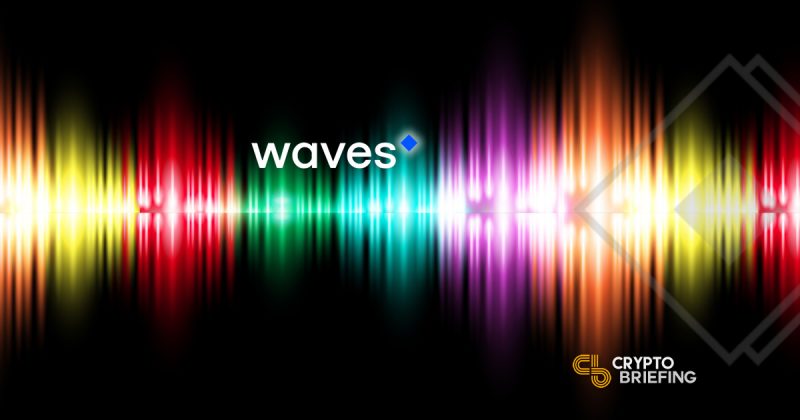
Share this article
Waves Digital Asset Report: Introduction
Waves debuted in the Spring of 2016, as one of the most successful ICOs of its day, attracting over $16 million worth of funds.
The platform was able to capitalize on the scalability issues of Ethereum during the ICO rush of 2017 to establish itself as one of the premier ICO hosting services. However, with the ICO market cooling Waves is searching for a new identity.
The early focus on DEX technology has vaulted Waves to the top of the niche space. Furthermore, the recent addition of smart contracts gives hope for the development of a dApps ecosystem. However, the lack of focus on marketing and community building makes the platform’s prospects for becoming the network of choice for developers and publishers.
Waves needs to focus on adoption of its technology, otherwise even its competitive products will lose out to rival offerings.
Part One: The Business Case
Waves Market Opportunities
The Waves platform is developing across three main directions: token platform, DEX, and dApp ecosystem. As such, Waves has the opportunity to become a player in several markets.
The platform first gained recognition for giving users the ability to quickly and easily create custom tokens. One of the key uses for the features was launching ICOs. The ICO market has been cooling since the summer, but projects were still able to attract over $800 million in October, using the crowdfunding mechanism.
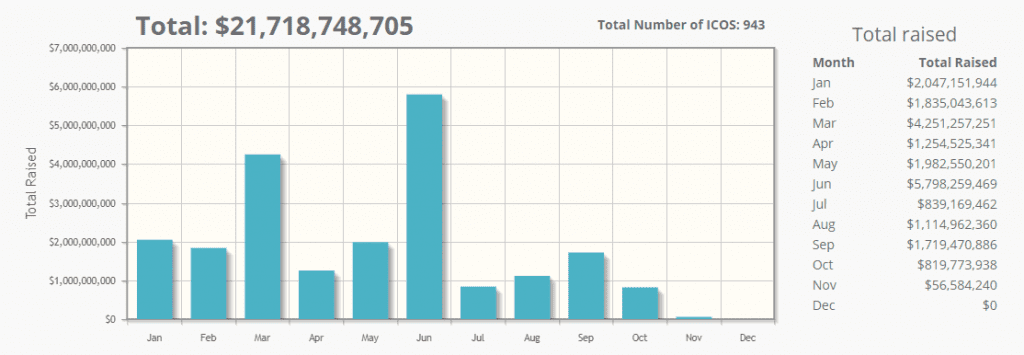
The November numbers could be disappointing, especially considering the expectations for a seasonal run-up that never materialized. However, as the ICO is drying up the STO market looks promising, with the expectations of $2-$3 billion in value in 2019. While those numbers don’t compare well to the $21.7 billion size of the 2018 ICO market, it might cushion the blow while the crypto industry goes through growing pains.
The token platform is energized by the Waves decentralized exchange. The DEX is considered to be the holy grail of the crypto trading world. As of now, trading volume in the industry is dominated by centralized exchanges. However, with improvement in transaction speeds and throughput, DEXs are becoming more competitive.
Crypto trading currently represents an $11 billion market opportunity. The top 10 exchanges have a 24-hour volume in the range of $200-$800 million, while even the most popular DEXs like IDEX cannot get into the coinmarketcap top 100. This represents a great opportunity for Waves. The top DEXs are posting around $1.5 million in volume, while Waves has been in the $500,000 zone.
This indicates that the space has not been claimed yet. Furthermore, Ethereum-based DEXs are currently significantly hampered by the underlying network scalability and cost challenges.
The combination of the DEX and user-friendly token creation can make Waves attractive for tokenization projects focusing on commodities and low liquidity assets such as real estate. Similarly, the $77 trillion global stock market can be up for grabs.
Finally, the release of smart contracts makes Waves a possible destination for dApp developers. While Waves has been late to the game with this technology, it could benefit from the pool of projects that launched their crowdfunding campaigns on the platform.
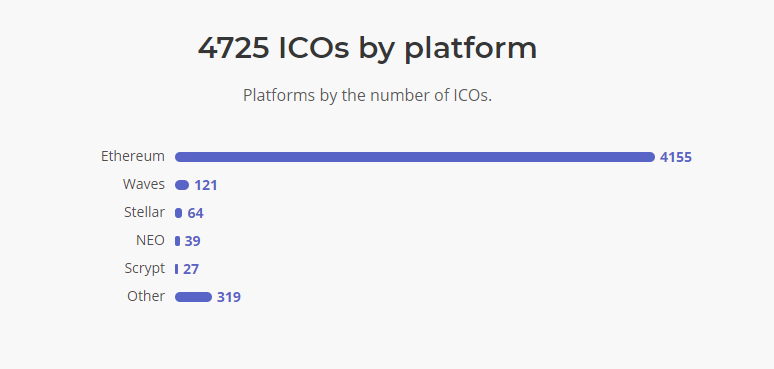
Waves has singled out gaming as a priority segment in the dApp space. While it is still in its infancy it will be growing with a target of a $137.9 billion traditional gaming market, $70.3 billion of which belongs to mobile applications.
However, without proper marketing the efforts will go unnoticed by the broad crypto community. Some of the competing networks, like EOS, are able to dedicate a great amount of funds to building the community. Waves will need to find ways to grow and maintain awareness of its ecosystem.
The platform will face stiff competition across all of its key segments. On the token and dApps front Ethereum and EOS are clear rivals, while Stellar offers the closest alternative to a three-pronged feature set. Furthermore, centralized players in the market such as Binance and Coinbase will create headwinds in the trading segment.
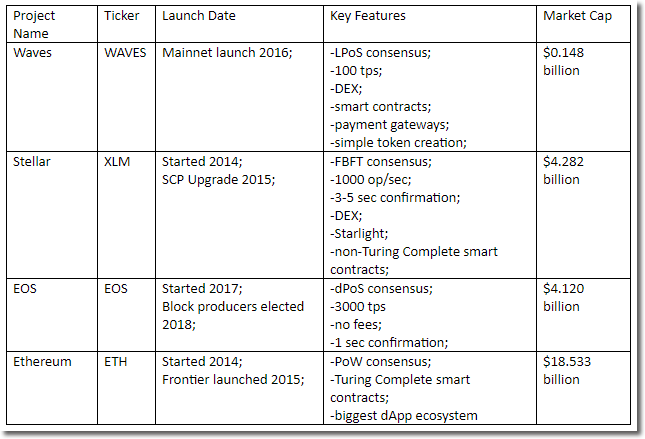
The difference in capitalization is, above all, and indication of community excitement. None of the projects, can claim domination over the space, if nothing else, because the industry is still growing and structuring.
However, when properly used, hype can be converted into adoption. The NVT comparison reveals a similar story. Waves transactions seem to be priced several times higher than that of Ethereum and EOS. The silver lining is that at least it’s in the same neighborhood, unlike Stellar.
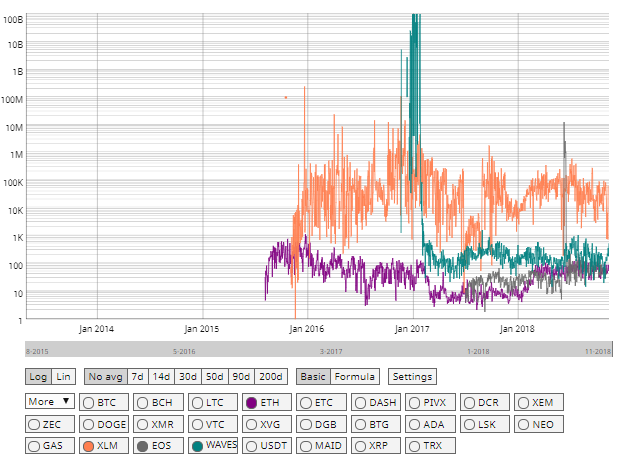
The capital reserves these projects possess, enable them to “buy” adoption. Waves will have a hard time competing with its bigger rivals if it continues to let them fortify their network effects.
Companies that are not currently building blockchain networks but are providing services are also a threat to the Waves ecosystem. Centralized exchanges and the like, are flush with cash and have already accumulated a large user base. Binance, for example, has over 10 million users and is expected to reach $1 billion in profits. This combination enables Binance to explore different growth avenues, from internal R&D to VC.
Binance is expected to launch the beta version of its DEX soon, and with its existing user base, it will have an imposing presence in the market.
| Company | Ticker | Product | Key Features | Market Cap |
| Binance | BNB | Binance Exchange | -can process 1.4 million tps;
-native token; -large selection of trading pairs; -top 3 exchange by volume; |
$1.083 billion
*does not include company valuation |
| Coinbase | n/a | GDAX | crypto-fiat pairs;
regulated; custody services; |
$8 billion (not publicly traded) |
Ultimately, there exists a significant market opportunity for Waves. Whether or not it is able to capitalize on it will depend on its ability to convince users and developers to give it a chance.
From a market opportunity perspective, Waves is growing in a logical and organic way. However, if it is not able to advertise its brand on par with its biggest rivals, its platform might become a ghost network, regardless of its technological merits.
Ecosystem Development
The Waves ecosystem is comprised of several infrastructure and organizational components. The backbone of the network is formed by nodes. Waves supports full nodes, and miner nodes:
- Full node – responsible for relaying blocks and transactions to miners and answering queries about the state of the blockchain; can also be a miner;
- Miner node – creates new blocks; requires a minimum of 1000 Waves (reduced from 10,000; can lease stake to a mining pool.
There are multiple instruments to incentivise community involvement and self-governance
The network uses LPoS to achieve consensus, but user involvement goes beyond mere transaction validation. The platform implements network improvements using a voting process. When new features are introduced miners vote on them before they are introduced into the system. Features have one of three states on the blockchain: defined, approved, activated. For a feature to get implemented it must obtain at least 80% of the votes from the last 10,000 blocks. Once a feature has been approved, node operators have 10,000 blocks to update the software.
That is not the only self-governance mechanism on the network. Waves released a WCT token to facilitate a kind DAO community. Token holders are allowed to rate projects, vote on key ecosystem initiatives, such as which ERC20 token would be listed on the Waves DEX, and benefit from airdrops.
While the concept went dormant for some time, it has recently been revived as part of the TrustAmust project. This is a decentralized crowdfunding incubator in which users vote with WCT token for candidate projects that can later do DAICO rounds on the platform.
The simplicity of token creation is a major differentiating factor.
All of these initiatives are supported by the token creation and trading infrastructure of the platform. Waves supports the quick creation of user issued tokens. The network appears to promote a “you can tokenize anything” approach, which has been incentivized by a multitude of fiat and crypto gateways and multiple different project token implementations. The platform is also convenient for conducting airdrops. Combined with low KYC/AML barriers (only for fiat deposit/withdrawals), Waves offers a user-friendly environment for project launches and asset propagation.
The listing and exchange of assets is facilitated by the Waves DEX. The exchange is one of the core propositions of the network. It enables users to transact Waves and tokens while maintaining full control of their assets.
Viable DEX solutions are in demand, but hard to come by, with transaction speed and liquidity being the biggest stumbling blocks. Waves attracts traders with one of the best front-end/interfaces on the market, centralized exchanges included.
Also, the auto-list feature for user issued tokens is an important differentiator. Waves boasts near real time transaction execution and an average 24h volume of over $6,300,000, but during the ongoing bear market, actual daily volume has been substantially lower.
It must also be noted that while Waves highlights security as one of the features of the exchange, it suffered a hack during its launch.
Waves is getting ready to make a pivot towards security tokens.
Waves is also launching a separate DEX for security tokens, as part of its Tokenomica initiative. Although the project seemed to have been shuttered during the summer, due to legal challenges, it now looks to be revived. With the industry turning its attention to security tokens, Waves is smart to be creating the necessary infrastructure for them.
Separately, the ecosystem saw the start of project Vostok. This is a blockchain integration solution based on Waves NG, that targets enterprise clients. It offers, among other features, private blockchain and blockchain administrator functionality. Waves and Vostok engage in a lot of knowledge sharing around development. Vostok is the ecosystem’s foray into the private B2B space.
With the recent launch of smart contracts, Waves became a player in the dApp space as well. Initially, Waves attracted projects for the ease of launching a crowdfunding campaign. However, some of these projects, like Tradingene, are now planning on implementing Waves smart contracts. It should be noted that while some projects are trying to use Waves beyond the token launch functionality, the platform does not specifically try to convince token launch users to use the network for product development.
The platform has a questionable record when it comes helping projects develop on the platform.
The Waves team has implemented several initiatives to strengthen and empower the community. They launched the Waves Lab incubator with a budget of 1 million Waves. It was started to help pre-ICO startups working with the Waves platform with: funding, legal support, advice, resources, PR and marketing.
However, projects report a lack of financial support, and the inability of the incubator to provide any expertise or help beyond access to media channels. In addition, Basics Fund was launched to invest in blockchain infrastructure.
Waves has also launched an ambassador program to get its community members involved in increasing awareness of the platform. This particular initiative appears to be unstructured, but according to Waves marketing, has yielded 30-50 community events around the globe, per month. The success of the effort has inspired an offshoot, tech ambassador program, to focus on the development effort.
The most recent Waves initiative involves dedicating 1 million Waves to incentivize game development using Waves technology. The gaming project is meant to create momentum behind the smart contract release and related Waves development projects.
While the effort is definitely a positive sign for the ecosystem, it is clearly a drop in the sea compared to what its rivals are doing. EOS, for example, promised to commit $1 billion to developing its ecosystem. It is not a secret that due to the decline of the ICO market development teams are looking to network foundation funds to attract capital. As such, network choice is often driven by financial motivation rather than technological merit of the chosen platform.
Despite the impressive depth and breadth of the ecosystem, Waves remains somewhat of an enigma in the industry.
While it scored a few notable partnership victories, such as the agreement with Deloitte to cooperate around ICO services, Gazprombank Digital and the Burger King Russia loyalty program, it seems to be struggling in finding big-name friends. Vostok’s tie-ups with government organizations in Russia could be promising on the local market but simultaneously seriously damaging to the ecosystem as a whole, with the mounting political tensions and sanctions levied against Russia.

In terms of community involvement, Waves is doing okay, but it is losing out in network activity relative to Ethereum and EOS. Considering the head start Waves had on EOS, these numbers are concerning.
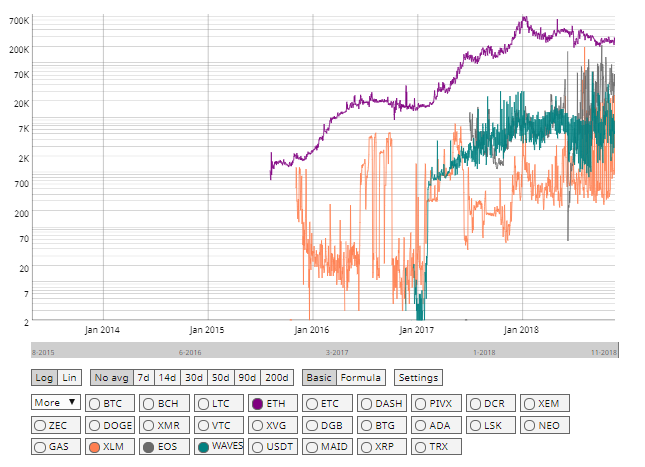
Ultimately, if Waves does not focus on awareness and adoption of its technology and continues to slide under the radar, its rivals will establish insurmountable networking moats.
Alexander Ivanov stated in an interview that Waves is a technology first enterprise, with everything else being secondary. However, if that continues to be the case, Waves will not be able to compete with the likes of Ethereum, EOS and Stellar.
Token Economics
Waves is a native currency of the Waves platform and is used as both a medium of exchange and a consensus instrument. The platform also enables user to create custom tokens, and currently supports two native network tokens.
Waves:
Stakes – Waves uses a LPoS consensus protocol. Waves native currency is used for staking by the mining node operators. The size of the stake affects the odds that a node gets selected as a block creator. Stakes can be leased out to pools.
Fees and Rewards – Waves are used to pay for transactions (0.001 Waves) on the network and smart account (0.005 Waves) operations. Non-Turing Complete Contracts operate on fixed fee basis. Block creators split the transaction fee reward as follows: 40% to the current epoch leader and 60% to the next epoch leader. In addition, Waves token holders get community benefits, such as access to Vostok public token sale, which will be open exclusively to Waves owners.
Payment and Speculation – Waves has multiple fiat gateways and is also traded on multiple exchanges.
UIA – The platform supports the creation of custom tokens.
WCT
Rating and Voting – the token enables users to participate in rating projects and community decision-making. WCT tokens will also be used in an associated project TrustAmust.
Rewards – WCT token holders may receive airdrops, from the platform and participating projects.
MRT
Rewards – Block creators received a reward in the form of MRT tokens (60 MRT per block for the first 70 blocks they generate per day and 30 MRT per block after). MRT tokens redistributed through the buyback are allocated proportionally to nodes, based on blocks generated, with a 70-block daily limit.
The total supply of Waves stands at 100 million coins. 85 million were sold in the ICO, 1 million distributed to early supporters, 1 million for post-ICO bounties, 4 million for strategic partners and backers and 9 million for the development team.
10 million WCT tokens have been distributed.
10 million MRT tokens have been distributed. Waves has initiated a 500 Waves daily buyback, with 20% of MRT burned and the rest redistributed to miner nodes.
The Waves 40-60 miner incentive model is a legacy of the Bitcoin NG protocol on which Waves NG is based. It was chosen as an optimal ratio to push the node operators to follow the protocol.
The LPoS consensus algorithm that the network uses is essentially a variation of a DPoS and tends to promote centralization. This can be clearly seen in the distribution of the network’s block generators, where the top 10 nodes account for almost 80% of block generation.
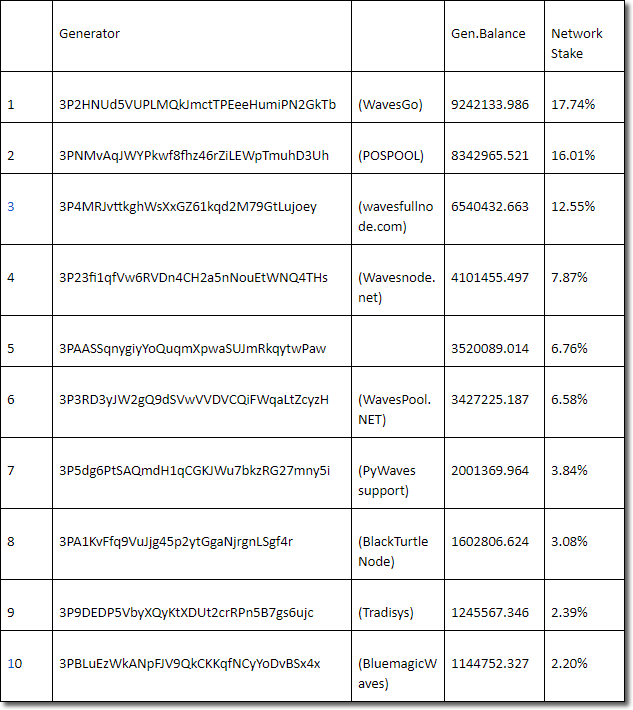
This is a common problem with major blockchain networks today, where either mining pools or a few elected nodes dominate the network. However, what makes Waves stand out is that it is making an actual effort to address the issue.
During the summer Waves implemented Fair-Proof-of-Stake update to the consensus algorithm that corrected issues with fair block distribution and security vulnerabilities. Furthermore, Waves supports small nodes and pools and has started a Community Node Program to incentivize full node creation, by leasing Waves to them. There are further proposals being considered by the network, one of which is to use the node balance as a cap for leasing.
The network has demonstrated a concerted effort to maintain user incentives in the ecosystem. The native tokens are a great example of that. The MRT token was used to counterbalance a lack of transactions on the network during its early days. Low transaction totals resulted in smaller fee rewards and MRT tokens gave miners an extra incentive.
The WCT tokens were designed to stimulate user activity in the community, by giving token holders an ability to rate and vote and gain rewards through airdrops.
The easy process of token creation enables Waves to integrate new incentives in the future if the need/opportunity arises.
| Project Name | Ticker | UIA | Key Uses | Total Supply |
| Waves | WAVES | Yes | -payment;
-tokens; -dApps -DEX; |
100 million |
| Ethereum | ETH | Yes | -payment;
-tokens; -dApps; |
120.2 million |
| Stellar | XLM | Yes | -payment;
-tokens; -dApps -DEX; |
104.44 billion |
| EOS | EOS | Yes | -payment;
-tokens; -dApps; |
1 billion + up to 5% yearly inflation |
Waves token supply and economic incentives are very attractive for network users, especially compared to some of its chief rivals. The bigger networks use inflationary models while Waves has a fixed supply that, if anything, could exhibit deflationary characteristics.
On top of that, Waves has maintained the flexibility for added incentives with network tokens that can be used to provide users with additional benefits without eroding the value of the core currency.
Furthermore, the network deserves to be commended on its effort to increase decentralization. While some PoS-based networks use marketing to justify decentralization sacrifices with efficiency gains, Waves appears to listen to user discontent and attempts to make improvements.
However, due to low industry awareness of these strength, Waves is not really part of the decentralization vs centralization debate. The network has sound token economics, but with a low level of adoption that will not be enough to support asset prices.
Lead Team
Aleksander Ivanov, CEO – Aleksander has 15+ years of IT and entrepreneurship experience. He founded Intelligence Unitrade, which launched such projects as Coinomat. Aleksander is the founder of Waves Platform and Vostok project.
Artem Kalikhov, CTO – Artem has 10+ years of experience in IT and financial services space, including stints at Sberbank and Alpha-bank. He is currently heading up the Vostok project.
Ilya Smagin, Smart Contract Development Lead – Ilya has nearly a decade of software development experience, with stints at Gazprom, Yandex and Deutsche Bank.
Maxim Pertsovskiy, COO – Maxim founded Green Garage Makerspace in 2014, and joined Waves Platform in 2016.
Philipp Eryushev, CMO – There is not a lot of info available about Philipp. He has started his career in digital sphere in 2012, went to work for iConText in 2013, and joined Waves Platform in 2017.
Waves has assembled a technically gifted team, which has earned the respect of the community it serves. The network also allocates a 3-person team to support external projects’ teams with development on the networks. In addition, each week one of the platform’s backend engineers takes part in forum discussions.
However, some of the projects questioned reported problems with getting adequate support from Waves, while others reported that with “serious development questions” the quality and likelihood of a response depended entirely on the individual support person you were lucky (or unlucky) to get.
On the other hand, marketing and general management are considered to be glaring weaknesses when it comes to human capital. One of the projects working with the platform described the team as having “very strong technical people, but a lot of people on the management side – it is not clear why they are even there”.
Marketing staff do not appear to be fully engrossed in the project, which is a disservice to the project. There is also a division between sales and marketing, which creates a feeling of a mature corporate machine, but the are no tangible results to support such an image.
Furthermore, the ecosystem is comprised of a number of seemingly standalone projects, with each one only partially aware of the workings of the others. It appears that Waves is tripping over classical IT-startup stumbling blocks: there is a tendency to overcommit on the technology side with the hope that the other functions such as operations and marketing will somehow take care of themselves.
Part Two: The Technology Case
Underlying Technology
The foundation of the Waves platform is the Waves NG consensus protocol, which is a derivation of the Bitcoin NG protocol. The original protocol separates times into epochs and utilizes key blocks and microblocks to improve scalability and latency properties. A leader is selected for each epoch, that is alone responsible for the serialization of transactions and block creation.
This drastically improves throughput and latency of the network. Waves NG went a step further: combined the key blocks and the microblocks into liquid blocks and replaced the PoW approach with LPoS, which is essentially a variation of DPoS.

To create a liquid block:
- The miner node gets the permission to create a block.
- The miner node creates and sends the key block (which does not contain transactions).
- The miner node creates and sends the micro blocks (which contain transactions just as in normal block with a reference to previous micro block or key block) with mining time interval of three seconds.
- Miners will mine those micro blocks and propagate them directly to the network until the next new key block appears with a referencing to the liquid block.
Epoch leaders are selected randomly based on the stake ratio of the miner nodes. Nodes can lease stakes to increase the chance of being selected.
Waves kept the same reward structure, with 40% of the block reward going to the epoch leader, and 60% going to the next epoch leader.
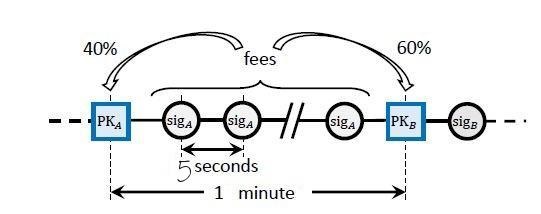
The network performance is solid, but not spectacular. The platform advertises 100tps, with a maximum tested speed of 300-400 tps, a cap dictated by the block size. However, when interviewing a project working closely with the Waves DEX, it was revealed that the actual live transaction rate is closer to 50-60 tps.
| Project Name | Ticker | Consensus Protocol | TPS | Time to Confirmation |
| Waves | WAVES | LPoS | 100 tps | 10 min |
| Ethereum | ETH | PoW | 25 tps | 6 min |
| Stellar | XLM | FBFT | 1000 ops | 5 sec |
| EOS | EOS | DPoS | 3000 tps | 5 sec |
The DEX, which represents one of the feature elements of the ecosystem utilizes Waves NG. While the exchange executes trades in near real time, the system is nowhere near being quick enough for frequency trading.
However, centralized exchanges face the same issue, so in that sense DEX does not limit crypto-trading functionality. It must be noted that the Waves DEX is not fully decentralized. The trades are centrally matched, which, in theory, opens up the possibility of order book manipulation. Given the low volumes in the DEX space, they have not faced scrutiny over their numbers the way centralized exchanges have. Yet, it is not beyond the realm of possibilities that the order books may be manipulated.
However, Waves does offer some unique security features. For example, the leasing functionality of the Waves NG protocol enables node operators to mine from one node while keeping their balance on another node. This negates a lot of typical hacking attacks. Getting access to a wallet associated with the mining node will not yield anything for the attacker.
Recently, Waves activated the Smart Accounts on its mainnet, marking the first phase of smart contract implementation on the network. Smart accounts differ from ordinary accounts in that they check criteria requirements for transaction before submitting them to be included in a block. The platform is intended to have both non-Turing Complete and Turing Complete smart contracts. Waves uses RIDE language for defining smart contracts.
Waves approach to smart contracts can be described functionalistic and minimalistic. The language was striped of all non-essential elements, and this barebones design affords greater security and ease of use.
The first iteration of smart contracts is not Turing Complete. However, as Waves smart contract lead Ilya Smagin explained, non-Turing Complete smart contracts can cover the vast majority of use cases needed in the market space. In fact, it appears that Waves wants to achieve Turing Completeness on a system level rather than on a smart contract level.
As it stands the network supports twelve transaction types.
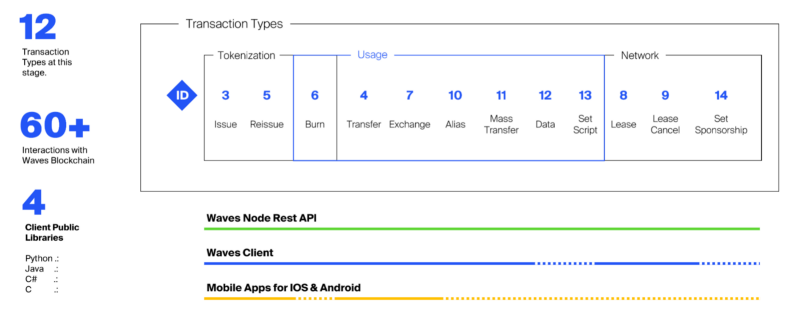
Since, Waves is a technology first project, it is natural that its upcoming catalysts are all technology-driven. Currently, there is work being done in the following areas:
- state channels as a layer on top of the blockchain for execution;
- update for smart contracts;
- non-fungible tokens;
- smart assets.
The non-fungible tokens deserve special mention as they could do a lot to help Waves’ effort to establish itself in the gaming space. The network appears to be growing in a logical and organic way, such that the architecture supports future development and growth.
Roadmap
Waves has a publicly available roadmap for 2018, with several key goals including smart contracts and atomic swaps.
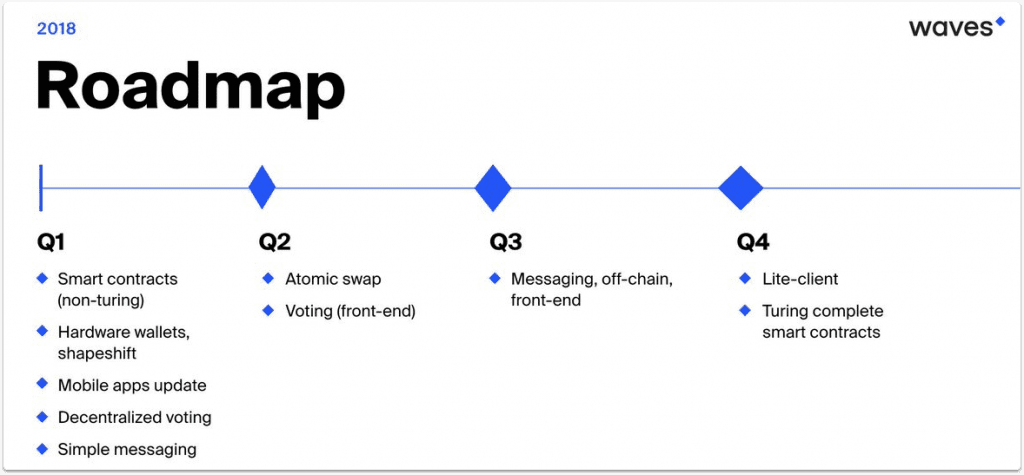
The release of smart contracts has been significantly delayed pushing forward other goals. It is unclear why the launch was delayed, given that the smart accounts were in the testnet for quite some time.
Furthermore, based on conversations with the team, it appears as if the plans for Turing Complete contracts may be scrapped altogether if the majority of use cases will be covered without Turing Completeness. There is not enough transparency around the development process, so it is difficult to surmise the exact level of progress of the team.
A point of concern is the development of Vostok platform, which has no clear roadmap. Aleksander Ivanov stated in the summer that Waves and Vostok will have a unified development team.
There is concern within the community that Waves is pivoting, and a lack of transparency on the development effort does little to alleviate fears that Waves is switching gears to Vostok.
Part Three: The Investment Case
Token Performance
Waves has been hit especially hard by the ongoing bear market. It has lost over 92% of its value from it ATH in December of 2017.
While Waves and its rivals have very similar price charts, Waves exhibits the strongest decline slope, which does not bode well in the short term.
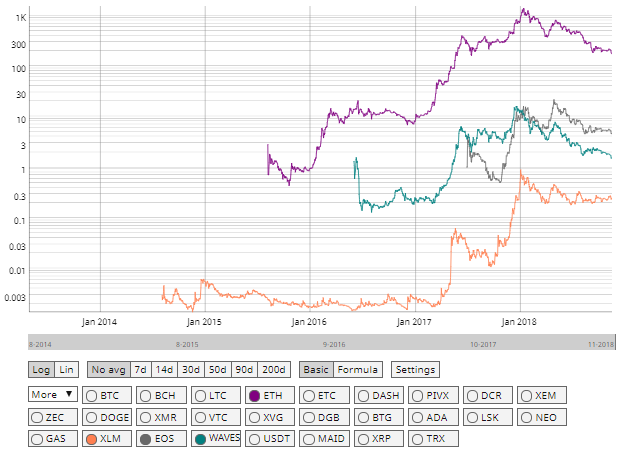
With the market cap eroding, Waves is on the verge of slipping out of the coinmarketcap top 50. While this is more of a psychological barrier, it does highlight the platform’s difficulty in establishing widespread following.
The biggest Waves market, by far, is Waves/BTC. It is notable that Waves is only the third Waves/BTC volume by exchange, with Tidex holding the dominant position. Waves ecosystem is built to support a self-sufficient market, but it appears that the wider community is not buying into it yet.
The dominance of external exchanges is also an indicator of the speculation being the dominant use case for the currency. With the implementation of smart contracts opening up doors for dApp development, it will be important to see if that starts to change.
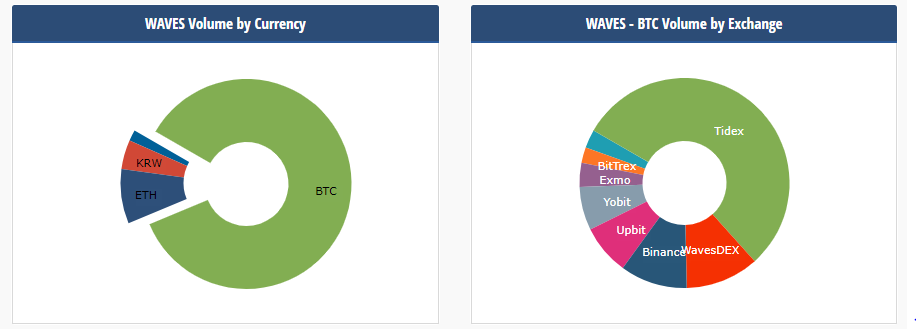
The drop off in volume during the past year, further supports the waning popularity storyline. While the major players have volume numbers that oscillate around a stable axis, Waves exhibits a solid downtrend.
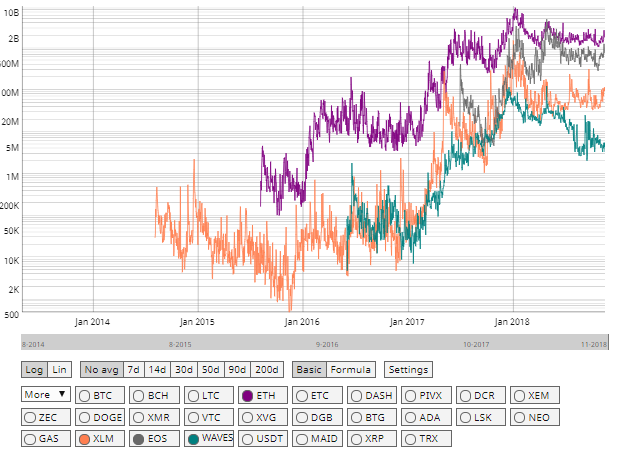
One of the byproducts of this bear market has been a decrease in the 30-day volatility, and here, Waves is not much different from its competition.
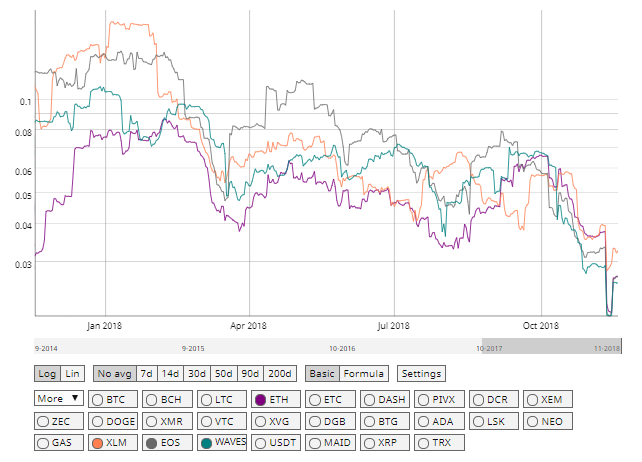
Low volatility can benefit Waves’ effort to grow its dApp ecosystem, as predictable costs are a major factor for developing and supporting an application.
Live data and more information about Waves can be found here.
UPDATE: 12/6/2018 – Please note that ‘transaction count’ does not include Coinbase or Coinstake tx.
Share this article
